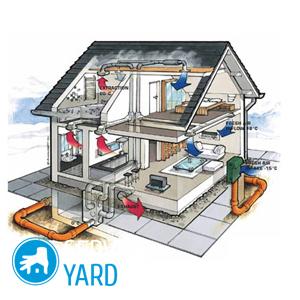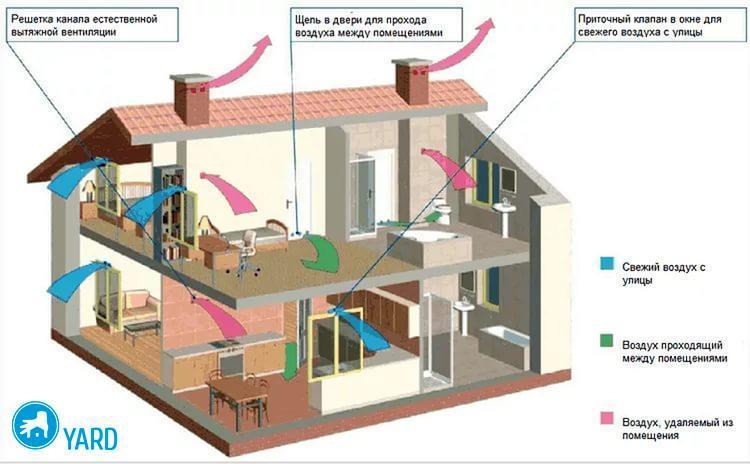DIY ventilation in a private house - scheme

Build a house with your own hands and know about all the necessary systems for organizing a healthy microclimate inside the building? This article will discuss the ventilation in a private house with your own hands. The scheme of work and the selection of components should be thought out as carefully as possible even before the start of the arrangement. Otherwise, the mismatch in the quality of air purification can provoke a rapid destruction of the entire decoration of the building, and even cause health problems for all residents of the house.
to contents ↑General scheme for creating ventilation in a private house
Arrangement of ventilation in a private house occurs according to the following algorithm:
- Calculation of air exchange.
- Selection of the cross section of the ducts.
- Choosing the type of ventilation system.
- Making a diagram of the ventilation of a private house with your own hands. These work such as defining:
- locations of fan devices;
- places of fresh intake;
- exhaust air discharge;
- places of passage of air ducts.
Natural or mechanical ventilation system?
In order for a person to be comfortable in the house, the organization and maintenance of an optimal microclimate is necessary. In this case, not only the optimum air temperature is important, but also such an indicator as its speed.
Important! The lower the speed, the more comfortable the stay in the room. Thus, in terms of comfort, natural ventilation has an undeniable advantage.
If the house is equipped with forced-air and mechanical ventilation with fans installed on the exhaust and air flow, the air exchange will be more intense than in a living room with a natural air exchange.
In this case, the air velocity is.
- For natural ventilation - up to 1 cubic meter per hour.
- For mechanical ventilation - from 3 to 5 cubic meters per hour.
However, there are nuances due to which mechanical ventilation is sometimes not enough. With a decrease in the speed of the air stream along the channel, the size of the required section increases:
- It is not always possible to place a large section channel in the wall.
- It is not very aesthetically pleasing to put the canal outside the walls, as in some public and office premises.
Therefore, it becomes necessary to use a mechanical type hood. But to equip only a natural flow of air into the room is also not always possible.
to contents ↑Air supply
Consider its main sources, as well as measures to increase the amount of supply air. As already mentioned, the flow of fresh air into the room can be both natural and forced. Let's consider in more detail how to make ventilation in a private house with your own hands.
Infiltration
This is air intake through leaks in the walls, windows and doors of a house. If the housing area is small (about 100-140 squares), and the windows use old-style wooden frames, then such a natural influx is quite enough for good ventilation, especially if you take into account the additional air flow through the walls and the doorway.
Ventilation
Installation of modern windows with profiles made of metal-plastic provides greater tightness of the room. Ventilation helps solve the problem of air entering the room.
Often use the installation of a plastic window in the ventilation position. This method has its drawbacks:
- Significant heat loss.
- The cooling of the window unit and adjacent slopes in the winter, as a result - the formation of condensate.
Important! Full air exchange is carried out within 0.5-1.25 hours.
Airing with fully open windows is devoid of these disadvantages:
- The room is fully ventilated in 4-10 minutes.
- Window constructions do not cool, condensation does not form.
Important! If you ventilate the room with fully open windows and doors, the air exchange time is accelerated to 2-4 minutes, but you need to be careful about drafts.
Using window and wall air inlets
The use of metal-plastic window structures seals the room. Leak-free technologies do not exist. The designers solved this problem by equipping the window structures with adjustable ventilation slots in the upper part of the window.
If you have already installed plastic windows of a “traditional” design, then you can solve the problem as follows:
- By installing wall air inlets. Wall air inlets are round nozzles that are mounted right through the wall and closed on both sides by grilles. The internal grilles are adjustable, from closed to open. It is advisable to install valves at the window openings so that they can be masked with curtains. In addition, the incoming air in this case falls into the range of radiators located under the windows.
Important! If you install a supply valve behind the battery, the air entering the room immediately warms up.
- Valves can be equipped with filters, temperature and humidity sensors. They are recommended to be installed in the bedroom, dining room and hall, to comply with the direction of air movement: from “clean” rooms to household ones (bathroom, kitchen, bathroom).
- Air-supply valves in houses with walls insulated with vapor-tight materials (e.g. polystyrene foam, EPS) have proven themselves well.
Important! The amount of fresh air supplied by the supply valves is from 50 to 100 cubic meters per hour. To determine the required number of valves in the house, there is a special calculation technique when drawing up a ventilation scheme for a private house with your own hands.
Fan forced flow
Sometimes when calculating it turns out that it will be necessary to install the supply valves under each window. If you do not want to do this for reasons of aesthetics, then the problem can be solved by forcing fresh air by fans.
The structure of the ventilation scheme in a private house with your own hands (supply system) includes:
- Ventilation network.
- Ventilation equipment.
In addition to the fan itself, ventilation equipment includes:
- Silencer
- Filter.
- Air valve.
- Heater.
Important! The filter cleans the incoming air from dust particles. Using a heater, the air warms up in the cold season (not all systems are equipped with heaters). Distinguish between electric and water heaters. Hydraulic air heaters are more expensive, because their installation is associated with the additional use of mixing units.
The ventilation network includes:
- Ducts.
- Devices for the distribution of air flow.
- Air intake grilles.
to contents ↑Important! If the house uses a mechanical way of supplying and extracting air, then to save energy spent on heating, experts recommend installing a recovery system.
Cooker hood
If you are building a house from scratch, then the project must provide for ventilation ducts in the walls of such rooms as a kitchen, a bathroom, a bathroom. If there is no possibility for the arrangement of internal wall channels, they are performed as side shafts.
There are such types of channels for ventilation in a private house:
- Internal placed in a brick wall.
- Attached channels.
- Ventilation pendant ducts.
- Conclusion to the roof from the ventilation shaft.
Natural air extract
If the volume of air venting is small, then natural extraction is quite enough. In the interior of the room, the channel is closed using a ventilation grill.
Mechanical type hood
It is used to reduce the cross section of the ventilation duct necessary for the natural extraction of air. The problem is solved by exhaust fans, which are installed in bathrooms, kitchens and bathrooms.
The most popular of the exhaust fans are flush mounted devices and wall-mounted devices.
Important! Convenient fans equipped with humidity sensors. Such a device works until the specified humidity level is established in the room. The cost of such devices is slightly higher compared to conventional ones.
When choosing a fan, you should pay attention to models equipped with rubber bushings for sound absorption. The device works with less noise.
Air recovery principle
If the house has an air conditioning system, then the air coming from the street is partially cooled. In order to reduce the load on the air conditioner, recuperators are installed. The essence of this principle of arranging ventilation in a private house is as follows: the cooled exhaust air passed through the recuperator cools the warm supply air from the street.
to contents ↑Stock footage
Installation of ventilation in a private house is a very serious issue, which is advisable to entrust to specialists. However, the basic knowledge that we shared in this article will never hurt.
- How to choose a vacuum cleaner taking into account the characteristics of the house and coatings?
- What to look for when choosing a water delivery
- How to quickly create comfort at home - tips for housewives
- How to choose the perfect TV - useful tips
- What to look for when choosing blinds
- What should be running shoes?
- What useful things can you buy in a hardware store
- Iphone 11 pro max review
- Than iPhone is better than Android smartphones




